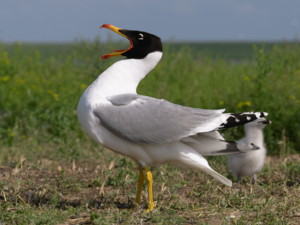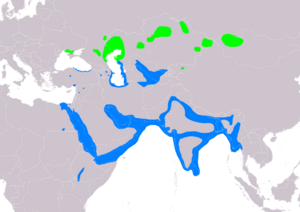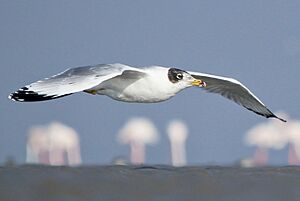Pallas's gull facts for kids
Quick facts for kids Pallas's gull |
|
|---|---|
 |
|
| Conservation status | |
| Scientific classification | |
| Genus: |
Ichthyaetus
|
| Species: |
ichthyaetus
|
 |
|
| Range of I. ichthyaetus Breeding Non-breeding | |
| Synonyms | |
|
Larus ichthyaetus |
|
The Pallas's gull (Ichthyaetus ichthyaetus) is a very large bird species. It is also known as the great black-headed gull. Its scientific name comes from Ancient Greek words. Ichthyaetus means "fish eagle." This name fits because these gulls often eat fish!
Where Pallas's Gulls Live
Pallas's gulls make their nests in large groups called colonies. They prefer marshes and islands. You can find them breeding from southern Russia all the way to Mongolia.
These gulls are migratory birds. This means they travel long distances. They spend their winters in warmer places. These include the eastern Mediterranean Sea, the Arabian Peninsula, and India.
Sometimes, a Pallas's gull might fly far off its usual path. When this happens, it is called a "vagrant." These gulls are sometimes seen as vagrants in western Europe. They also visit parts of the Indian Ocean and the coasts of Africa.
What Pallas's Gulls Look Like
The Pallas's gull is a truly giant bird! It is the largest gull with a black head in the world. It is also the third largest gull species overall. Only the great black-backed gull and the glaucous gull are bigger.
These gulls are about 55 to 72 centimeters (22 to 28 inches) long. Their wings can spread very wide, from 142 to 170 centimeters (56 to 67 inches). Males usually weigh around 1.6 kilograms (3.5 pounds). Females are a bit lighter, at about 1.22 kilograms (2.7 pounds).
Adult Pallas's gulls are easy to spot in summer. No other gull this big has a black head, called a "hood." Their wings and back are grey. They have bright white spots, like "mirrors," on their wing tips. Their legs are yellow, and their bill is orangey-yellow with a red tip.
Younger gulls and adults in winter look a bit different. They have a dark patch around their eyes. This patch is a hint of the black hood they will get later. It takes about four years for young gulls to grow into their full adult feathers.
Sounds and Food
Pallas's gulls make a deep, rather loud call. It sounds a bit like "aargh." This call is similar to the sound made by the lesser black-backed gull. While they can be noisy when they are nesting, these gulls are usually quiet at other times.
These birds are predators. This means they hunt for their food. They eat many different things. Their diet includes fish, crabs, insects, and even small mammals.
The Pallas's gull is an important bird. It is protected by an agreement called the Agreement on the Conservation of African-Eurasian Migratory Waterbirds (AEWA). This agreement helps protect birds that migrate across Africa and Eurasia.
Images for kids








